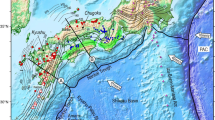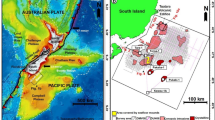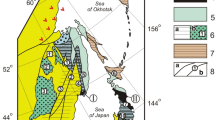Abstract
Observations of peculiar volcanic objects, made by a submersible on the deep sea floor at a depth of about 2,600 m at and near the axis of the East Pacific Rise during the CYAMEX expedition as part of the RITA Project1 are presented here. Two basic types of flow forms were observed within the crestal area of the East Pacific Rise: pillow flows and fluid lavas, the latter sometimes overlying massive flows. The East Pacific Rise at 21° N comprises an axial, unfaulted extrusion zone bordered by an extension zone characterised by faulting2,3. Pillow flows occupy the innermost or extrusion zone and constitute small elongated volcanic highs. Fluid lavas tend to occur at the edge of the adjacent extension zone in bathymetric lows controlled by normal faults or steep primary slopes of constructional highs. In the 50 × 200 m lows which border the extrusion zone the fluid lava is smooth and lobate surfaces which represent the upper surface of the flow are locally collapsed and reveal the internal structure of the fluid lavas. Where the roof collapse is extensive, layered columnar features are visible and volcanic layering can be seen against the flank of the bordering volcanic highs (Figs 1–3). Similar features have been reported from the Galapagos Rift4. The diameter of the approximately cylindrical pillars ranges from 0.5 to 2 m. Some pillars are made of multiple coalescent cylinders. The tops of the pillars are glassy, funnel-shaped and always widening upwards. The pillars were presumed to be hollow from several observations of gashes or openings in the vertical walls of the pillars. This was demonstrated during dive CY 78–19 to the south where a small pillar was toppled by CYANA and subsequent examination revealed a circular canal along the axis of the pillar. The outer surface of the pillars is marked by centimetre-thick glassy, subhorizontal ledges extending several centimetres from the outer vertical surface of the pillars (Figs 2–4). The ledges are spaced every 2–5 cm and show small lava stalactites hanging on the under-side of the ledges. Examination of large layered fragments of pillars recovered by CYANA demonstrated that the layering is only a surface feature as it does not extend through the basaltic mass of the pillars. The apparent layering is due to glass ledges adhering to a vertical basaltic pipe. In some rare instances the pillar outer surface showed no ledges and instead a smooth surface corrugated with vertical grooves. Some pillars are inclined or slightly curved; others get narrower towards the base. The pillars are almost totally aphyric and have the same bulk composition as other lava types recovered in the axial zone of the East Pacific Rise at 21° N (ref. 5).
This is a preview of subscription content, access via your institution
Access options
Subscribe to this journal
Receive 51 print issues and online access
$199.00 per year
only $3.90 per issue
Buy this article
- Purchase on Springer Link
- Instant access to full article PDF
Prices may be subject to local taxes which are calculated during checkout
Similar content being viewed by others

References
CYAMAX Scientific Team Eos 59, 1198 (1978).
Normark, W. R. Geology 4, 681–685 (1976).
CYAMEX Team, Bougault, H., Cambon, P. & Eissen, J. P. Submarine basalts collected by diving saucer on the East Pacific Rise at 21° N, and on the Tamayo Transform Fault (in the press).
Ballard, R. D., Holcomb, R. T. & Van Andel, T. H. Sheet Flows, Collapse Pits and Lava Lakes of the Rift Valley (in the press).
CYAMEX Scientific Team Manned submersible dives on the East Pacific Rise 21° N (Project RITA) (in the press).
McBirney, A. R. Bull. Volcanol. 26, 455–469 (1963).
Fuller, R. E. Am. J. Sci. 21, 281–300 (1931).
Waters, A. C. Am. J. Sci. 258 -A, 350–366 (1960).
Moore, J. G. & Richter, D. H. Bull. geol. Soc. Am. 73, 1153–1158 (1962).
Author information
Authors and Affiliations
Rights and permissions
About this article
Cite this article
Francheteau, J., Juteau, T. & Rangan, C. Basaltic pillars in collapsed lava-pools on the deep ocean-floor. Nature 281, 209–211 (1979). https://doi.org/10.1038/281209a0
Received:
Accepted:
Published:
Issue Date:
DOI: https://doi.org/10.1038/281209a0
This article is cited by
-
Structure and organization of submarine basaltic flows: sheet flow transformation into pillow lavas in shallow submarine environments
International Journal of Earth Sciences (2012)
-
Interaction of sea water and lava during submarine eruptions at mid-ocean ridges
Nature (2003)
-
Volcanic growth faults and the origin of Pacific abyssal hills
Nature (1996)
-
Atlantic lava lakes and hot vents
Nature (1995)
-
The origin of bathymetric highs at ridge-transform intersections: A multi-disciplinary case study at the Clipperton Fracture Zone
Marine Geophysical Researches (1994)
Comments
By submitting a comment you agree to abide by our Terms and Community Guidelines. If you find something abusive or that does not comply with our terms or guidelines please flag it as inappropriate.


